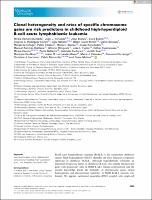| dc.contributor | Vall d'Hebron Barcelona Hospital Campus |
| dc.contributor.author | Ramos-Muntada, Mireia |
| dc.contributor.author | Trincado Alonso, Juan Luis |
| dc.contributor.author | Blanco, Joan |
| dc.contributor.author | Bueno, Clara |
| dc.contributor.author | Rodríguez Cortez, Virginia Carolina |
| dc.contributor.author | Ortega Blanco, Margarita |
| dc.contributor.author | VELASCO, PABLO |
| dc.contributor.author | Bataller Torralba, Alex |
| dc.date.accessioned | 2023-05-24T11:41:46Z |
| dc.date.available | 2023-05-24T11:41:46Z |
| dc.date.issued | 2022-08 |
| dc.identifier.citation | Ramos-Muntada M, Trincado JL, Blanco J, Bueno C, Rodríguez-Cortez VC, Bataller A, et al. Clonal heterogeneity and rates of specific chromosome gains are risk predictors in childhood high-hyperdiploid B-cell acute lymphoblastic leukemia. Mol Oncol. 2022 Aug;16(16):2899–919. |
| dc.identifier.issn | 1878-0261 |
| dc.identifier.uri | https://hdl.handle.net/11351/9614 |
| dc.description | Clonal heterogeneity; Computational modeling; Risk predictors |
| dc.description.abstract | B-cell acute lymphoblastic leukemia (B-ALL) is the commonest childhood cancer. High hyperdiploidy (HHD) identifies the most frequent cytogenetic subgroup in childhood B-ALL. Although hyperdiploidy represents an important prognostic factor in childhood B-ALL, the specific chromosome gains with prognostic value in HHD-B-ALL remain controversial, and the current knowledge about the hierarchy of chromosome gains, clonal heterogeneity and chromosomal instability in HHD-B-ALL remains very limited. We applied automated sequential-iFISH coupled with single-cell computational modeling to identify the specific chromosomal gains of the eight typically gained chromosomes in a large cohort of 72 primary diagnostic (DX, n = 62) and matched relapse (REL, n = 10) samples from HHD-B-ALL patients with either favorable or unfavorable clinical outcome in order to characterize the clonal heterogeneity, specific chromosome gains and clonal evolution. Our data show a high degree of clonal heterogeneity and a hierarchical order of chromosome gains in DX samples of HHD-B-ALL. The rates of specific chromosome gains and clonal heterogeneity found in DX samples differ between HHD-B-ALL patients with favorable or unfavorable clinical outcome. In fact, our comprehensive analyses at DX using a computationally defined risk predictor revealed low levels of trisomies +18+10 and low levels of clonal heterogeneity as robust relapse risk factors in minimal residual disease (MRD)-negative childhood HHD-B-ALL patients: relapse-free survival beyond 5 years: 22.1% versus 87.9%, P < 0.0001 and 33.3% versus 80%, P < 0.0001, respectively. Moreover, longitudinal analysis of matched DX-REL HHD-B-ALL samples revealed distinct patterns of clonal evolution at relapse. Our study offers a reliable prognostic sub-stratification of pediatric MRD-negative HHD-B-ALL patients. |
| dc.language.iso | eng |
| dc.publisher | Wiley |
| dc.relation.ispartofseries | Molecular Oncology;16(16) |
| dc.rights | Attribution 4.0 International |
| dc.rights.uri | http://creativecommons.org/licenses/by/4.0/ |
| dc.source | Scientia |
| dc.subject | Infants |
| dc.subject | Anomalies cromosòmiques |
| dc.subject | Leucèmia limfoblàstica - Aspectes genètics |
| dc.subject.mesh | Precursor B-Cell Lymphoblastic Leukemia-Lymphoma |
| dc.subject.mesh | /genetics |
| dc.subject.mesh | Chromosome Aberrations |
| dc.subject.mesh | Child |
| dc.title | Clonal heterogeneity and rates of specific chromosome gains are risk predictors in childhood high-hyperdiploid B-cell acute lymphoblastic leukemia |
| dc.type | info:eu-repo/semantics/article |
| dc.identifier.doi | 10.1002/1878-0261.13276 |
| dc.subject.decs | leucemia-linfoma linfoblástico de células B precursoras |
| dc.subject.decs | /genética |
| dc.subject.decs | aberraciones cromosómicas |
| dc.subject.decs | niño |
| dc.relation.publishversion | https://doi.org/10.1002/1878-0261.13276 |
| dc.type.version | info:eu-repo/semantics/publishedVersion |
| dc.audience | Professionals |
| dc.contributor.organismes | Institut Català de la Salut |
| dc.contributor.authoraffiliation | [Ramos-Muntada M, Blanco J] Cell Biology, Physiology and Immunology Department, Genetics of Male Fertility Group, Universitat Autonòma de Barcelona, Spain. [Trincado JL] Department of Biomedicine, School of Medicine, Josep Carreras Leukemia Research Institute, University of Barcelona, Spain. CNAG-CRG, Centre for Genomic Regulation (CRG), Barcelona Institute of Science and Technology (BIST), Spain. Red Española de Terapias Avanzadas (TERAV), ISCIII, Barcelona, Spain. [Bueno C] Department of Biomedicine, School of Medicine, Josep Carreras Leukemia Research Institute, University of Barcelona, Spain. Red Española de Terapias Avanzadas (TERAV), ISCIII, Barcelona, Spain. Centro de Investigacion Biomédica en Red de Cáncer (CIBER-ONC), ISCIII, Barcelona, Spain. [Rodríguez-Cortez VC] Department of Biomedicine, School of Medicine, Josep Carreras Leukemia Research Institute, University of Barcelona, Spain. Red Española de Terapias Avanzadas (TERAV), ISCIII, Barcelona, Spain. [Bataller A] Department of Biomedicine, School of Medicine, Josep Carreras Leukemia Research Institute, University of Barcelona, Spain. Red Española de Terapias Avanzadas (TERAV), ISCIII, Barcelona, Spain. Hematology Department, Hospital Clínic de Barcelona, IDIBAPS, University of Barcelona, Spain. [Ortega M] Experimental Hematology, Vall d’Hebron Institute of Oncology (VHIO), Barcelona, Spain. Servei d’Hematologia, Vall d’Hebron Hospital Universitari, Barcelona, Spain. [Velasco P] Servei d'Hematologia i Oncologia Pediàtriques, Vall d’Hebron Hospital Universitari, Barcelona, Spain |
| dc.identifier.pmid | 35726693 |
| dc.identifier.wos | 000827314000001 |
| dc.rights.accessrights | info:eu-repo/semantics/openAccess |

